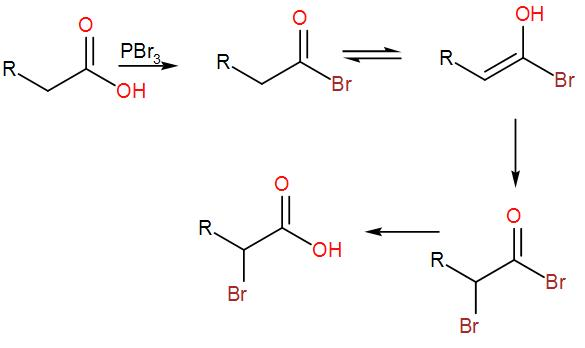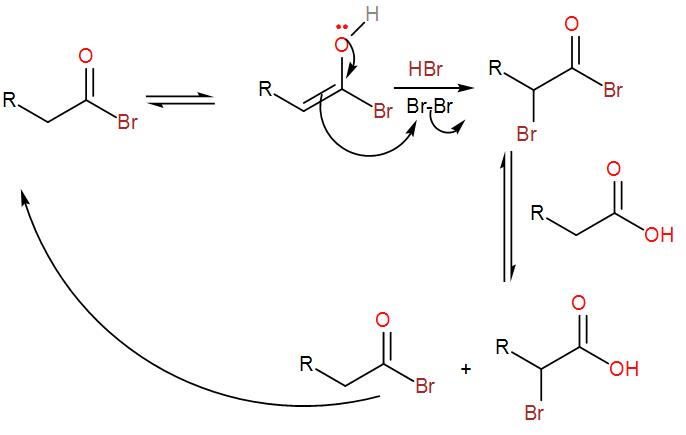
Explain HVZ reaction with example.
Answer
430.1k+ views
3 likes
Hint:This reaction is named after three scientists. It is a commonly used reaction in organic chemistry. It is generally used for synthesis of halogenated compounds.
Complete step by step answer:
HVZ reaction is the abbreviation for Hell-Volhard-Zelinsky reaction. It is a halogenation reaction i.e. addition reaction which adds one or more halogen to the compound. It halogenated carboxylic acids at the alpha carbon position.
We can write the following reaction as-

Treatment of carboxylic acids with bromine and phosphorus cause selective bromination of the acid and forms a brominated acid.
Now we will discuss the mechanism of the reaction-
-The first step is the formation of phosphorus tribromides from bromine and catalytic amount of phosphorus.
-The phosphorus tribromide converts the carboxylic acid into acyl bromide in the next step-

-The acyl bromide formed is tautomerised to its enol form and this tautomer rapidly brominates at the alpha carbon position-

-As the mono-brominated compound is less nucleophilic, the reaction stops at this stage. The formed acyl bromide can again react with the remaining unreacted carboxylic acid and the cycle continues until the conversion is complete.
The most common example of Hell-Volhard-Zelinsky reaction is in the preparation of alanine where a mixture of bromine and phosphorus tribromide is used to form 2-bromopropionic acid which is then converted into a mixture of amino acid-
Additional information: In a neutral or slightly acidic medium, hydrolysis of the acyl bromide takes place simultaneously giving alpha bromo-carboxylic acid. If we want an aqueous solution, we have to use the full molar equivalent of phosphorus tribromide.
If a little nucleophilic solvent is added, acyl bromide intermediate is regenerated and a molar equivalent of phosphorus tribromide is used in order to overcome the slow reaction kinetics.
Note: It is important to keep in mind that this reaction is used for halogenation at the alpha position. Alpha carbon is the carbon next to the carbon to which the functional group is attached. This reaction is also generally carried out for bromination.
Complete step by step answer:
HVZ reaction is the abbreviation for Hell-Volhard-Zelinsky reaction. It is a halogenation reaction i.e. addition reaction which adds one or more halogen to the compound. It halogenated carboxylic acids at the alpha carbon position.
We can write the following reaction as-

Treatment of carboxylic acids with bromine and phosphorus cause selective bromination of the acid and forms a brominated acid.
Now we will discuss the mechanism of the reaction-
-The first step is the formation of phosphorus tribromides from bromine and catalytic amount of phosphorus.
-The phosphorus tribromide converts the carboxylic acid into acyl bromide in the next step-

-The acyl bromide formed is tautomerised to its enol form and this tautomer rapidly brominates at the alpha carbon position-

-As the mono-brominated compound is less nucleophilic, the reaction stops at this stage. The formed acyl bromide can again react with the remaining unreacted carboxylic acid and the cycle continues until the conversion is complete.
The most common example of Hell-Volhard-Zelinsky reaction is in the preparation of alanine where a mixture of bromine and phosphorus tribromide is used to form 2-bromopropionic acid which is then converted into a mixture of amino acid-
Additional information: In a neutral or slightly acidic medium, hydrolysis of the acyl bromide takes place simultaneously giving alpha bromo-carboxylic acid. If we want an aqueous solution, we have to use the full molar equivalent of phosphorus tribromide.
If a little nucleophilic solvent is added, acyl bromide intermediate is regenerated and a molar equivalent of phosphorus tribromide is used in order to overcome the slow reaction kinetics.
Note: It is important to keep in mind that this reaction is used for halogenation at the alpha position. Alpha carbon is the carbon next to the carbon to which the functional group is attached. This reaction is also generally carried out for bromination.
Latest Vedantu courses for you
Grade 9 | CBSE | SCHOOL | English
Vedantu 9 CBSE Pro Course - (2025-26)
School Full course for CBSE students
₹37,300 per year
Recently Updated Pages
Master Class 10 Science: Engaging Questions & Answers for Success

Master Class 10 Social Science: Engaging Questions & Answers for Success

Master Class 10 Maths: Engaging Questions & Answers for Success

Master Class 10 English: Engaging Questions & Answers for Success

Class 10 Question and Answer - Your Ultimate Solutions Guide

Master Class 9 General Knowledge: Engaging Questions & Answers for Success

Trending doubts
Give 10 examples of unisexual and bisexual flowers

Draw a labelled sketch of the human eye class 12 physics CBSE

Differentiate between homogeneous and heterogeneous class 12 chemistry CBSE

Differentiate between insitu conservation and exsitu class 12 biology CBSE

What are the major means of transport Explain each class 12 social science CBSE

What is the difference between resemblance and sem class 12 social science CBSE




